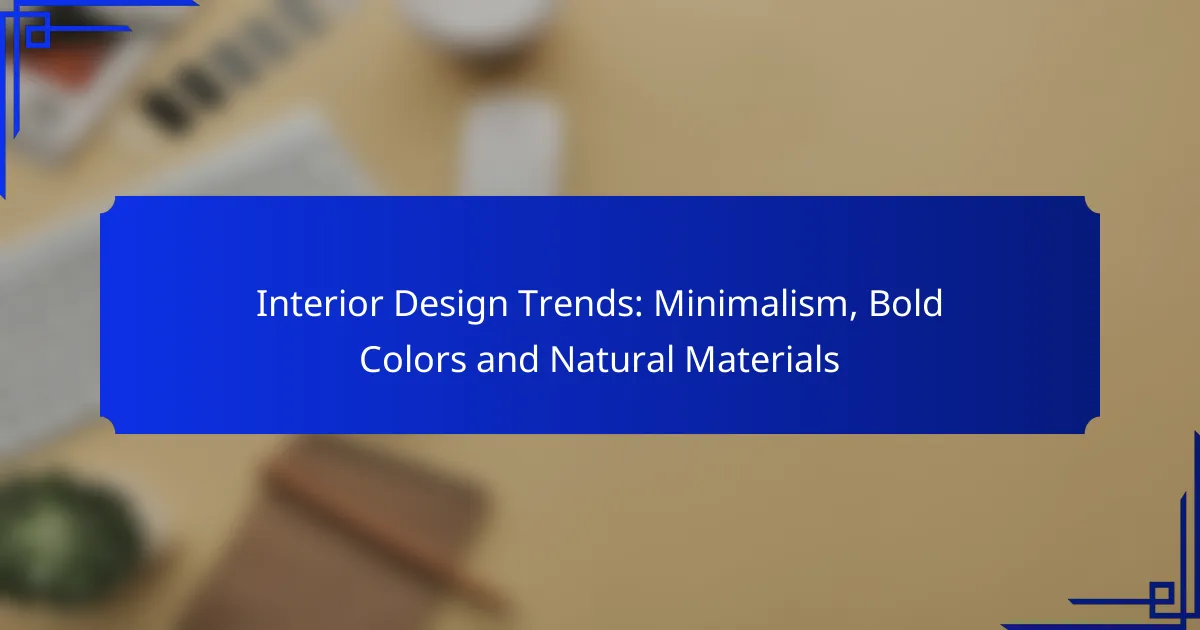The latest interior design trends highlight a harmonious blend of minimalism, bold colors, and natural materials, catering to a modern urban lifestyle. Emphasizing simplicity and functionality, minimalism creates serene spaces, while vibrant hues inject energy and personality into interiors. Additionally, the use of natural materials promotes sustainability, making these trends not only stylish but also environmentally conscious.

What are the latest interior design trends in major cities?
The latest interior design trends in major cities emphasize minimalism, bold colors, and the use of natural materials. These trends reflect a growing preference for simplicity, vibrancy, and sustainability in urban living spaces.
Minimalism in urban apartments
Minimalism in urban apartments focuses on creating open, uncluttered spaces that promote tranquility. This design style often features a neutral color palette, functional furniture, and a limited number of decorative items to enhance the feeling of spaciousness.
To achieve a minimalist look, consider investing in multifunctional furniture, such as a sofa bed or a coffee table with storage. Keep surfaces clear and only display a few carefully chosen decor pieces to maintain an airy atmosphere.
Bold colors in contemporary homes
Bold colors are making a significant impact in contemporary homes, allowing homeowners to express their personality and creativity. Vibrant hues such as deep blues, rich greens, and striking reds can be used as accent walls or in furniture pieces to create focal points.
When incorporating bold colors, balance is key. Pair bright shades with neutral tones to avoid overwhelming the space. Use accessories like cushions, artwork, or rugs to introduce color without committing to a full renovation.
Natural materials in eco-friendly designs
Natural materials are increasingly popular in eco-friendly designs, promoting sustainability and a connection to nature. Materials like reclaimed wood, bamboo, and stone not only enhance aesthetics but also reduce environmental impact.
To incorporate natural materials, consider using reclaimed wood for flooring or furniture, and opt for organic textiles for upholstery. This approach not only supports eco-conscious living but also adds warmth and texture to your home.

How to incorporate minimalism in your home?
Incorporating minimalism in your home involves simplifying your space by reducing clutter and focusing on essential elements. This design philosophy emphasizes functionality and a clean aesthetic, allowing for a more serene living environment.
Decluttering techniques
Effective decluttering starts with assessing each room and identifying items that are no longer needed or used. Consider using the “one in, one out” rule: for every new item brought into your home, remove an existing one. This helps maintain a balance and prevents accumulation.
Another useful technique is to categorize belongings into keep, donate, and discard piles. Set a timer for short sessions to avoid feeling overwhelmed, and tackle one area at a time, such as a drawer or a shelf. Regularly revisiting these areas can help maintain a minimalist approach.
Choosing a neutral color palette
A neutral color palette is essential for achieving a minimalist aesthetic, as it creates a calm and cohesive environment. Opt for shades like whites, beiges, grays, and soft earth tones to promote tranquility and spaciousness. These colors can make a room feel larger and more inviting.
When selecting a color scheme, consider using different textures and materials to add depth without introducing bold colors. For example, a combination of matte and glossy finishes can create visual interest while keeping the overall look understated. Limit accent colors to a few carefully chosen items to maintain the minimalist vibe.

What are the benefits of bold colors in interior design?
Bold colors in interior design can create striking visual impacts and enhance the overall aesthetic of a space. They draw attention, evoke emotions, and can transform the atmosphere of a room, making it feel more vibrant and alive.
Creating focal points
Using bold colors effectively can help establish focal points within a room. For instance, painting one wall in a deep hue can draw the eye and create a sense of depth. Accent furniture or decor items in vibrant shades can also serve as visual anchors, guiding the viewer’s attention to specific areas.
When selecting bold colors for focal points, consider the surrounding palette. Pairing a bright color with neutral tones can enhance its impact without overwhelming the space. A common approach is to use bold colors in smaller doses, such as in artwork or cushions, to maintain balance.
Enhancing mood and energy
Bold colors can significantly influence the mood and energy of a space. Warm colors like reds and oranges tend to create a lively and energetic atmosphere, making them suitable for social areas like living rooms or kitchens. In contrast, cooler tones like blues and greens can promote calmness and relaxation, ideal for bedrooms or study areas.
To maximize the mood-enhancing effects of bold colors, consider the natural light in the room. Bright, sunlit spaces can handle more intense colors, while darker areas may benefit from softer, bolder shades to avoid feeling cramped. Experimenting with different combinations can help find the right balance that resonates with your desired ambiance.

How to select natural materials for your space?
Selecting natural materials for your space involves considering sustainability, aesthetics, and functionality. Focus on materials that not only enhance the beauty of your interiors but also contribute to a healthier environment.
Choosing sustainable wood options
When selecting wood, prioritize sustainably sourced options such as bamboo, reclaimed wood, or FSC-certified timber. These choices reduce environmental impact and often come with unique character and history.
Consider the finish of the wood as well; water-based or natural oils are preferable to harsh chemicals, ensuring a safer indoor air quality. Look for woods that are durable and suitable for your climate to minimize maintenance.
Incorporating stone and clay elements
Stone and clay add texture and warmth to your space while being durable and low-maintenance. Natural stones like granite, marble, or slate can be used for countertops, flooring, or accent walls, providing a timeless appeal.
Clay materials, such as terracotta or earthenware, can be utilized in tiles or decorative items. These materials not only enhance aesthetics but also help regulate humidity, creating a more comfortable living environment.

What are the key factors to consider when designing a minimalist space?
When designing a minimalist space, focus on simplicity, functionality, and the effective use of space. Prioritize essential elements that enhance the overall aesthetic while avoiding unnecessary clutter.
Functionality over decoration
In minimalist design, functionality takes precedence over decorative elements. Each piece of furniture or decor should serve a purpose, contributing to the overall usability of the space. For example, choose multi-functional furniture, such as a coffee table that doubles as storage, to maximize efficiency.
Consider the flow of the space as well. Ensure that furniture placement allows for easy movement and access, avoiding any obstructions that could disrupt the minimalist aesthetic.
Quality over quantity
Emphasizing quality over quantity is crucial in minimalist design. Invest in fewer, high-quality items that are durable and timeless rather than filling the space with numerous low-quality pieces. This approach not only enhances the visual appeal but also reduces long-term costs associated with replacements.
When selecting materials, opt for natural and sustainable options like wood, stone, or metal. These materials not only add warmth and texture but also align with the minimalist philosophy of simplicity and authenticity.

How do bold colors affect interior design trends?
Bold colors significantly influence interior design trends by creating striking focal points and enhancing the overall mood of a space. They can energize a room, evoke emotions, and even define the style of a home.
Seasonal color palettes
Seasonal color palettes play a crucial role in interior design, as they reflect the changing moods and aesthetics throughout the year. For instance, warm tones like deep reds and oranges are popular in autumn, while cool blues and greens often dominate in spring and summer. Designers frequently update their color schemes to align with these seasonal trends, ensuring spaces feel fresh and inviting.
When selecting a seasonal palette, consider incorporating accent pieces such as cushions, artwork, or decorative items that can be easily swapped out. This allows for a dynamic look that can adapt to the seasons without a complete overhaul.
Impact on resale value
Bold colors can have a mixed impact on resale value, depending on buyer preferences and market trends. While vibrant hues may attract certain buyers, they can also deter others who prefer neutral tones. It’s essential to strike a balance between personal style and broader market appeal.
To maximize resale value, consider using bold colors as accents rather than primary wall colors. This approach allows potential buyers to envision their own style while still appreciating the unique character that bold colors can bring to a space.

What are the emerging trends in natural materials?
Emerging trends in natural materials focus on sustainability and aesthetic appeal, integrating resources that are eco-friendly and visually striking. Designers are increasingly using materials that not only reduce environmental impact but also enhance the overall ambiance of spaces.
Recycled materials in design
Recycled materials are gaining popularity in interior design as they offer a sustainable alternative to new resources. Items such as reclaimed wood, recycled glass, and repurposed metals can add unique character to spaces while minimizing waste.
When incorporating recycled materials, consider their source and quality. Look for certifications that ensure the materials meet safety and environmental standards. For example, reclaimed wood should be free of harmful chemicals and properly treated to prevent pests.
Biophilic design principles
Biophilic design principles emphasize the connection between nature and interior spaces, promoting well-being through natural elements. This approach often includes the use of natural materials, ample greenery, and designs that mimic natural forms.
To implement biophilic design, integrate features like living walls, large windows for natural light, and organic shapes in furniture. Aim for a balance between indoor and outdoor environments, which can enhance air quality and reduce stress levels.

How to balance minimalism with bold colors?
Balancing minimalism with bold colors involves using vibrant hues as accents against a clean, uncluttered backdrop. This approach allows for impactful design without overwhelming the space, creating a harmonious and visually appealing environment.
Choosing the right bold colors
Select bold colors that resonate with your personal style while complementing the minimalist aesthetic. Consider using colors like deep blues, rich greens, or vibrant yellows, which can serve as focal points in an otherwise neutral space. Test colors in small areas before committing to larger applications.
Using bold colors as accents
Incorporate bold colors through accessories such as cushions, artwork, or rugs. This method allows for easy updates and changes without altering the fundamental minimalist design. Aim for a few statement pieces rather than overwhelming the space with multiple colors.
Maintaining a minimalist backdrop
Keep the primary elements of your design simple and uncluttered. Use neutral tones like whites, grays, or soft earth tones for walls and larger furniture. This backdrop enhances the impact of your bold color choices, ensuring they stand out without competing for attention.
Creating a cohesive look
To achieve a cohesive look, ensure that the bold colors you choose harmonize with each other and the minimalist elements. Use a color wheel to find complementary colors and maintain a consistent palette throughout the space. This strategy helps unify the design while allowing for individuality.
